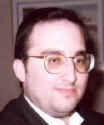|

|
D'var
Torah
by Rabbi Jay Spero |
Three
Sanctuaries
Parshas
Terumah
Contact Rabbi
Spero at 862-9546 or jsohr1@juno.com
If you are interested in receiving
Rabbi Spero's Dvar Torah in your email each week, please contact him at jsohr1@juno.com.
In
this week’s portion, Hashem commands Moshe to tell the Jews to build the
Mishkan, the Tabernacle.
The Mishkan was the prelude to the Beis Hamikdash, the temple. The Mishkan was a
sort of traveling temple, as the Beis Hamikdash would not be built until the
Jews had settled in Israel. "They shall make a Sanctuary for Me, so that I
may dwell amongst them" (Shemos 25:8).
What is the meaning of this verse? If Hashem is omnipresent, how could He be
confined to one place? And why would He find it necessary to do so?
As Jews we have the responsibility to sanctify the physical world. This is not
done through asceticism, but rather through injecting kedusha into our regular
physical activities (kedusha means "special" or "set aside")
— everything from eating to how we relate to our spouse. When Hashem created
man, He wanted man to have the unique ability to choose between good and evil.
However, in order for Hashem to create man with this balance, He had to limit
Himself, as Hashem is pure goodness. This process is called "tzimtzum",
contraction. Hashem must be in the world, but if He did not restrain Himself,
the world would be overwhelmed by His essence. If thus overwhelmed, man would
have no choice but to be good — as angels are — and would be deprived of
being good by choice.
Hashem did desire, though, that there be three sanctuaries where His presence
would be stronger: one in space, one in time, and one in people.
In the realm of space He chose the Mishkan/Beis Hamikdash. The Mishna recounts
that there were ten miracles performed in the Temple, some performed every day!
(Avos ch.5 Mishna 7). The essence of the Beis Hamikdash was more than an open
manifestation of Hashem’s glory. It was also a display of the depths to which
a person can communicate with Hashem, as any person, Jew or gentile, could offer
a sacrifice there (we will discuss, in the upcoming weeks, the idea behind
sacrifice).
In the realm of time there is Shabbos, a day when we step away from our jobs as
physical providers/creators and step into the spiritual role.
And in people there is a neshama, a soul. This is called a G-dly portion within
us. All Jews are born with pure unsullied souls with which they can improve the
world through good deeds and Torah study.
These three concepts all work together and play off one another. We have no more
Beis Hamikdash, may it be rebuilt speedily; but we do have a neshama; and we
have Shabbos. By utilizing the spiritual side in ourselves, through keeping
mitzvos and striving to be G-dly, and by connecting with the spiritual side in
time by keeping Shabbos, we can build a Mikdash in our neshama, and this will
hasten the coming of the Moshiach, when we will be able to truly see
spirituality in space — the Beis Hamikdash.
Rabbi
Jay Spero is the rabbi of the Saranac
Synagogue in Buffalo.
|
